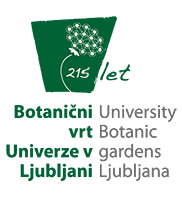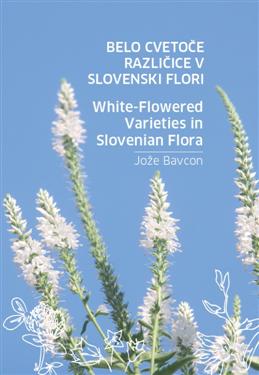
ISBN 978-961-6822-23-7
Number of pages: 349
Size: 16,6 x 23,5 cm
Text in Slovenian and English
The book was co-financed by the Slovenian Research Agency ARRS.
PRICE: 25 €
Only 300 copies!
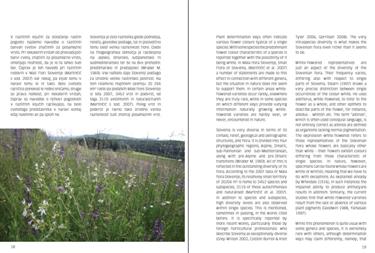
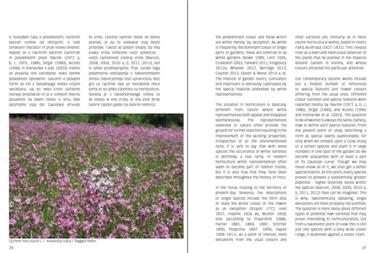
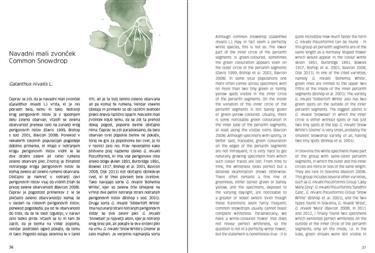
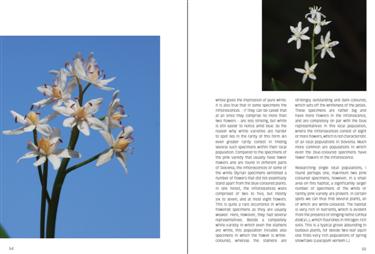
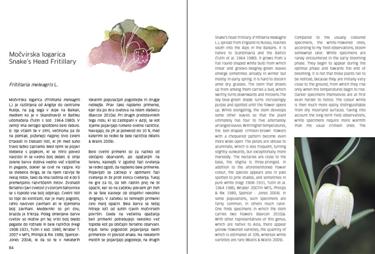
Conclusion
The work deals with the occurrence of white-flowered varieties whose flower colour differs from the usual flower colour of the original species. Šugar (1990) defines albinism as a lack of pigmentation in the organism. Petauer et al. (1998) explain it as a phenomenon resulting from a lack of colourants. A white flower is merely the most outstanding feature of albinism, which, however, is not entirely correct, as one must not neglect the presence of other pigments. Stearn (1997) draws a very precise distinction between single occurrences of the colour white, using such terms as: albescens – whitish, albicans – off-white, becoming white, albicaulis – white-stemmed, albidus – whitish, albiflorus – white-flowered, referring to the flower as a whole, albifrons – white-leaved, alboplenus – with double white flowers, albispinus – with white thorns, albocinctus – with a white crown, albomaculatus – spotted with white, albopictus – painted with white, albopapilosus – with white hairs, albovariegatus – variegated with white.
In white varieties (to apply the closest approximation in the Slovenian language) the flower alone is white, thus differing from the majority of representatives of a single genus or species in natural populations with normally differently coloured flowers. The colour white, however, appears in a variety of shades. In some plants only the petals are white, though even these can be faintly creamcoloured, in others the stamens or stigmas are different colour, with some flowers perfectly white. In other words, whiteflowered varieties appear both in all of these nuances and also in pure white.
The present work covers the representatives of different species and genera such as I found over decades of fieldwork in various parts of Slovenia. The actual research material would have been more copious, but the sampling method applied in the early years was not strictly systematic, meaning that not every single white variety was dug out, taken to the Botanic Garden, provided with a number and monitored as to its stability.
In the work, including a survey of the older Slovenian flora literature such as is at my disposal, I tried to establish whether albinism had also been reported by any previous authors. The problem is that numerous floras and determination keys do not refer to this particular feature. The fact that white representatives fail to be mentioned in the older works does not mean that individual authors were not aware of them. Comparing the works on the Slovenian flora with more recent articles dealing with horticultural issues, I found that the latter show a keen perception of the phenomenon and discuss it much more frequently than is the case in strictly botanical literature. Various keys to the determination of the Slovenian flora often indicate the possibility of a white-flowered variety, but such allegations are not always supported by the findings in nature. Therefore, I also give an assessment on whether white-flowered representatives are more frequent in a species or whether the searching for such representatives simply takes a longer period of time, sometimes even years. Based on years of fieldwork, I can say that in the habitats of single studied species white-flowered specimens were sometimes barely present at all, while remaining elusive elsewhere.
As following from the investigation, naturally growing white-flowered varieties are often much more vulnerable. Transferred to the Botanic Garden, where they are grown in culture, they can develop into plants whose growth habit, vigour, size, and branched inflorescences are equal to those of their naturally growing representatives. Where competition is eliminated and gardener’s help is at hand, white forms have better chances to survive, most of them revealing a very fine growth habit.
Concerning some of the species, the work deals with the cultivation of white representatives from seeds collected after open or controlled pollination. Seeds hardly ever develop between white varieties.
The work deals with white-flowered varieties of single genera and species potentially interesting for further cultivation of white varieties, together with selective breeding from the seedlings of these representatives. These representatives provide the possibility of obtaining new white-flowered varieties because some differ from those already present and denominated.
Kazalo / Index
Kazalo Index 5
Povzetek Conclusion 11
Uvod Introduction 17
Material in metodika Material and methodology 29
Rezultati in diskusija Results and discussion 35
Navadni mali zvonček Common Snowdrop Galanthus nivalis L. 36
Trobentica Primrose Primula vulgaris Huds. 40
Žafran Crocus Crocus L. 46
Dvolistna morska čebulica Two-leaf squill Scilla bifolia L. 50
Navadni jetrnik Common hepatica Hepatica nobilis Mill. 56
Pasji zob Dog’s tooth violet Erythronium dens-canis L. 60
Spomladanska resa Spring Heath Erica carnea L. 66
Navadni volčin Mezereon Daphne mezereum L. 72
Petelinček Corydalis Corydalis L. 78
Močvirska logarica Snake’s Head Fritillary Fritillaria meleagris L. 84
Jagodasta hrušica Common Grape Hyacinth Muscari botryoides (L.) Mill. 88
Brstična penuša, konopnica, mlaja Coral Root Cardamine bulbifera (L.) Crantz (Dentaria bulbifera L.) 92
Navadni zimzelen Lesser Periwinkle Vinca minor L. 96
Navadna mračica Globe Daisy Globularia punctata Lapeyr. 100
Lisasta mrtva kopriva Spotted Deadnettle Lamium maculatum L. 104
Vijolični lučnik Purple Mullein Verbascum phoeniceum L. 106
Navadna potonika Common Peony Paeonia officinalis L. 110
Ilirska perunika Illyrian Iris Iris pallida Lam. subsp. illyrica (Tommasini) T. Wraber 114
Kojniška perunika Kojnik Iris Iris sibirica L. subsp. erirrhiza (Pospichal) T. Wraber 118
Jacquenov ranjak Anthyllis jacquinii A. Kern 122
Rdeča relika Purple Broom Chamaecytisus purpureus Scop. 124
Plazeči skrečnik Blue Bugle Ajuga reptans L. 132
Kukavičja lučca Ragged Robin Lychnis flos-cuculi L. 136
Vretenčasti ušivec Whorled Lousewort Pedicularis verticillata L. 144
Moknati jeglič Bird’s-Eye Primrose Primula farinosa L. 148
Idrijski jeglič Idrija primrose Primula x venusta Host 150
Najmanjši jeglič Fairy Primrose Primula minima L. 154
Navadni jesenček Burning Bush Dictamnus albus L. 156
Francoski lan Blue Flax Linum narbonense L. 160
Materina dušica Common Thyme Thymus L. 162
Triumfettijev glavinec Squarrose Knapweed Centaurea triumfettii All. 164
Rožnati gadnjak Pink Salsify Scorzonera rosea Waldst. & Kit. 166
Ptičja grašica Tufted Vetch Vicia cracca L. 168
Čopasta grebenuša Tufted Milkwort Polygala comosa Schkuhr 170
Rdeča špajka Red Valerian Centranthus ruber (L.) DC. 172
Travniška kadulja Meadow Clary Salvia pratensis L. 176
Žajbelj Common Sage Salvia officinalis L. 184
Ilirski meček Wild gladiolus Gladiolus illyricus Koch 186
Gozdni slezenovec Common Mallow Malva sylvestris L. 192
Navadni ruj Eurasian Smoke Tree Cotinus coggygria Scop. 194
Velecvetna črnoglavka Large Self-heal Prunella grandiflora (L.) Scholler 198
Pisana šmarna detelja Crown Vetch Coronilla varia L. 202
Črna detelja Red Clover Trifolium pratense L. 204
Vrtna ostrožica Larkspur Consolida ajacis (L.) Schur 210
Avstrijski lučnik Verbascum austriacum Schott ex Roem. & Schult. 212
Repuščevolistna zvončica Creeping Bellflower Campanula rapunculoides L. 216
Repuščeva zvončica Creeping Bellflower Campanula rapunculus L. 220
Breskovolistna zvončica Peach-Leaf Bellflower Campanula persicifolia L. 222
Scheuchzerjev repuš Horned Rampion Phyteuma scheuchzeri All. 224
Glavičasti repuš Round-Headed Rampion Phyteuma orbiculare L. 226
Lepki osat Yellow Melancholy Thistle Cirsium erisithales (Jacq.) Scop 228
Barrelierov jetičnik Veronica barrelieri Schott ex Roem. & Schult. (Pseudolysimachion barrelieri (Schott ex Roem. & Schult.) Holub) 232
Navadni gadovec Blueweed Echium vulgare L. 238
Vetrovka, orličastolistni talin Greater Meadow-Rue Thalictrum aquilegiifolium L. 242
Navadni vrednik Wall Germander Teucrium chamaedrys L. 246
Potrošnik Chicory Cichorium intybus L. 248
Poljski grintavec Southern Scabious Scabiosa triandra L. 252
Navadna ciklama Common Cyclamen Cyclamen purpurascens Mill. 254
Črni bezeg Black Elder Sambucus nigra L. 264
Robati luk Mouse Garlic Allium angulosum L. 268
Lepi luk Keeled Garlic Allium carinatum L. subsp. pulchelum Bonnier & Layens 274
Gorski luk German Garlic Allium senescens L. 276
Barvilna mačina Saw Wart Serratula tinctoria L. 280
Gorska nebina European Michaelmas Daisy Aster amellus L. 282
Obmorska nebina Sea Aster Aster tripolium L. 284
Pritlikavi šetraj Satureja subspicata Bartl. ex Vis. subsp. liburnica Šilić 288
Diskusija Discussion 293
Zaključek Conclusion 311
Zahvala Acknowledgements 317
Literatura Literature 327
Stvarno kazalo Subject index 345





